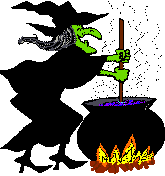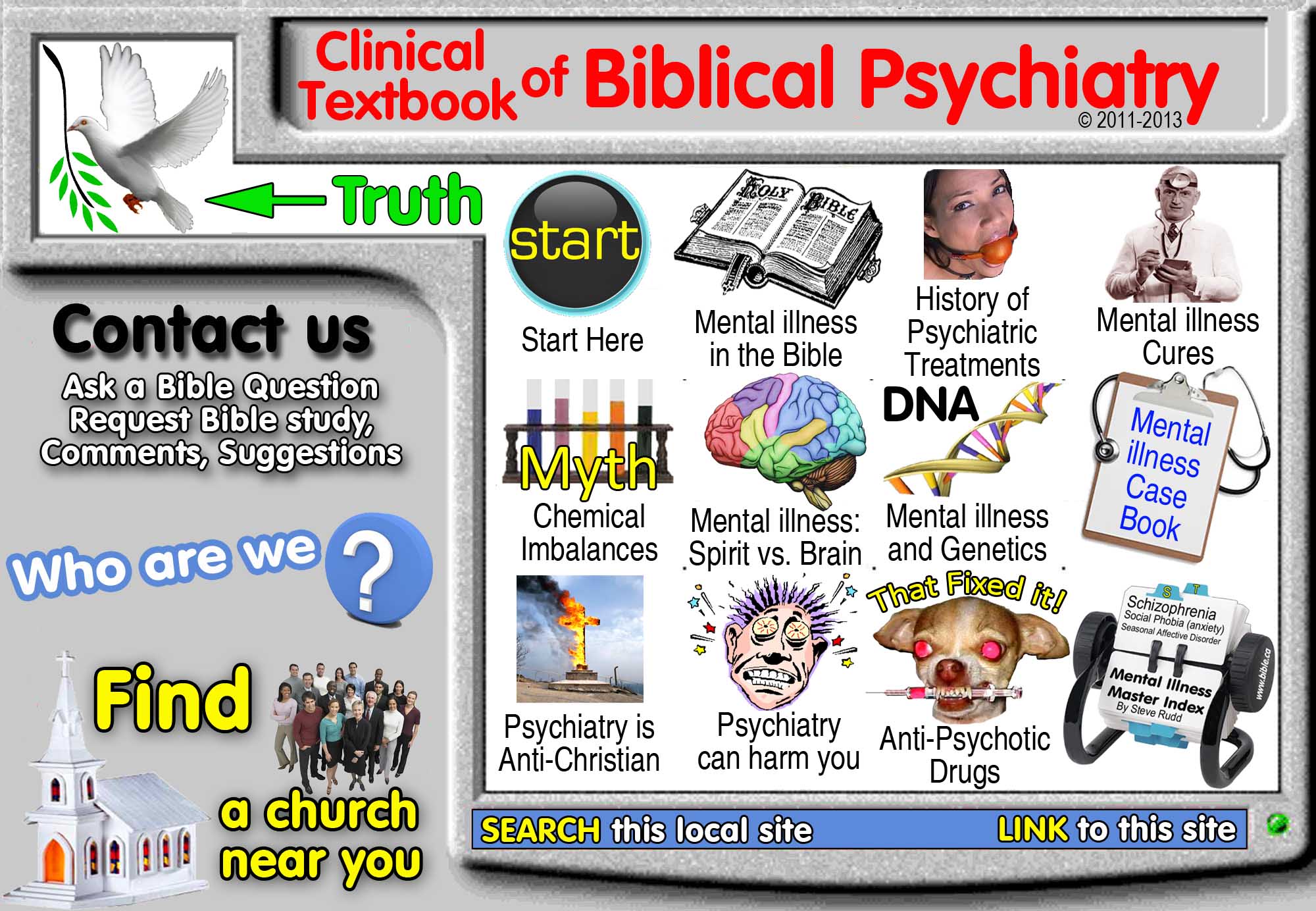Phobias:
Social Anxiety Disorder (Social Phobia) is pure Junk science.
Psychiatry is Junk
science
|
|
||
|
|
Snapshot:
Phobia |
|
|
|
||
A. Snapshot summary: Phobia
1. Social Anxiety Disorder, also known as Social Phobia, is a behaviour choice not a disease.
2. People become anxious because they lack self-control.
3. People can feel panic for many reasons:
a. Seeing a spider or snake.
b. Being in public.
c. Suddenly remembering they are 3 payments behind on their mortgage.
4. Treating Anxiety Disorders with drugs is like smashing a computer because of a software virus.
5. While people may condition and train themselves to experience sudden panic fits for an infinite number of specific things, it is not a disease.
6. Jesus commands us to be anxious for nothing. Anxiety is a sinful behaviour choice which is "cured" through self-control not drugs.
B. What biopsychiatrists, drug companies and governments say:
Notice they admit they have no idea what causes it: "Research to define causes of social anxiety is ongoing"
1. What Causes Social Anxiety Disorder? Research to define causes of social anxiety is ongoing. Some investigations implicate a small structure in the brain called the amygdala in the symptoms of social anxiety. The amygdala is believed to be a central site in the brain that controls fear responses. ... What Treatments Are Available for Social Anxiety? Research supported by NIMH and by industry has shown that there are two effective forms of treatment available for social anxiety: certain medications and a specific form of short-term psychotherapy called cognitive-behavioral therapy. Medications include antidepressants such as selective serotonin reuptake inhibitors (SSRIs) and monoamine oxidase inhibitors (MAOIs), as well as drugs known as high-potency benzodiazepenes. (Social Anxiety Disorder, Freedom From Fear, Staten Island, NY, National non-profit Mental Illness Advocacy Organization)
2. Treatment of Anxiety Disorders: In general, anxiety disorders are treated with medication, specific types of psychotherapy, or both (Anxiety Disorders, National Institute of Mental Health, NIMH, 2006)
3. Scientists currently think that, like heart disease and type 1 diabetes, mental illnesses are complex and probably result from a combination of genetic, environmental, psychological, and developmental factors. ... Several parts of the brain are key actors in the production of fear and anxiety. (Anxiety Disorders, National Institute of Mental Health, NIMH, 2006)
4. "Among the most tenacious nosological disagreements are incidences when it is suspected that a normal behavior has been mislabeled as abnormal in the DSM. Recent debates have focused on whether or not gender identity disorder (Bartlett, Vasey, and Bukowski, 2000), acute stress disorder (Harvey and Bryant, 2002; Marshall, Spitzer, and Liebowitz, 1999), and social anxiety disorder (Campbell—Sills and Stein, 2005; Swinson, 2005; Wakefield, Horwitz, and Schmitz, 2005) are examples of mental illness or normal problems in living. Nonetheless, each of these disorders remains in the DSM." (The Journal of mind and behavior, Guy A. Boysen, v28, p 157-173)
5. "Etiology: Biological Theories: Several biological theories of panic disorder are prominent in the psychiatric literature. We summarize the evidence for or against some of the most promising of these. Certain agents have a powerful and specific capacity to induce panic, in contrast with other agents that produce prominent physiological changes but fail to induce panic. These findings argue strongly against the notion that panic is a reaction to nonspecific distressing stimuli and suggest more specific biological bases, even if these involve multiple neurochemicals and circuits. The various theories discussed in this subsection need not be viewed as mutually exclusive, but rather as potentially interlocking pieces of a larger puzzle Neurochemical, imaging, and genetic findings are described as well." (Textbook of Clinical Psychiatry, Hales, Yudofsky, 2003 AD, p 549)
6. "Psychosocial theories. A number of mechanisms are proposed by learning theories as contributors to the pathogenesis of social phobia (Ost 1987; Stemberger et al. 1995). These include direct exposure to socially related traumatic events, vicarious learning through observing others engaged in such traumatic situations, and information transfer, things that one hears in various contexts regarding social interactions. There is a significant familial component to social phobia, part of which is thought to be heritable (see "Genetics" under "Biological Theories" subsection below) and part acquired. Parents, whether socially anxious themselves or not, might rear socially anxious children through various mechanisms such as lack of adequate exposure to social situations and development of social skills, over protectiveness, control-ling and critical behavior, modeling of socially anxious behaviors, and fearful information conveyed about social situations (Hudson and Rapee 2000)." (Textbook of Clinical Psychiatry, Hales, Yudofsky, 2003 AD, p 573)
7. "Biological theories. Genetics. A strong familial risk for social phobia has been identified, which is believed to be partly heritable and partly environmental. First-degree relatives of probands with generalized social phobia have an approximately 10-fold higher risk for generalized social phobia or avoidant personality disorder (M.B. Stein et al. 1998a). ... Neurochemistry. Neurochemical studies of social phobia have not been as systematic or as consistently replicated." (Textbook of Clinical Psychiatry, Hales, Yudofsky, 2003 AD, p 574)
8. "Phobias: Etiology: Psychodynamic Theory: With the 1909 publication of the case of Little Hans, Freud started to develop a psychological theory of phobic symptom formation (Freud 1909/1955). Little Hans was a 5-year-old boy who developed a phobia of horses. Through an analysis of the boy's conversations with his parents over a period of months, Freud hypothesized that Little Hans's unconscious and forbidden sexual feelings for his mother and aggressive, rivalrous feelings for his father, blocked from discharge because of repression, became physiologically transformed into anxiety, which was then displaced onto a symbolic object, in this case horses, the avoidance of which partly relieved Little Hans's anxiety. Freud later reconceptualized the case of Little Hans in the context of his evolving structural theory. Freud postulated that phobic symptoms occur as part of the resolution of intrapsychic conflict between instinctual impulses, superego prohibitions, and external reality constraints. Signal anxiety is experienced by the ego when such unconscious impulses threaten to break through. Such anxiety serves to mobilize not only further repression but, in the case of phobia formation, projection and displacement of the conflict onto a symbolic object, which can then be avoided as a neurotic solution to the original conflict. In the case of Little Hans, sexual feelings for his mother, aggressive feelings toward his father, and the guilty fear of retribution and castration by his father generated anxiety as a signal of oedipal conflict. The conflict became displaced and projected onto an avoidable object, horses, which Little Hans consequently feared would bite him. According to Freud, such a phobic symptom had two advantages. It avoided the ambivalence inherent in Little Hans's original conflict, as he not only hated but also loved his father. It also allowed his ego to cease generating anxiety as long as he could avoid the sight of horses. The cost of this compromise was that Little Hans had become housebound. Psychodynamic work with phobias, then, focuses on the symbolic meanings that the phobic object carries for any individual and the conflicts which is serves to avoid." (Textbook of Clinical Psychiatry, Hales, Yudofsky, 2003 AD, p 580)
9. "Phobias: Behavioral Theories: In learning theory, phobic anxiety is thought to be a conditioned response acquired through association of the phobic object (i.e., the conditioned stimulus) with a noxious experience (i.e., the unconditioned stimulus). Initially, the noxious experience (e.g., an electric shock) produces an unconditioned response of pain, discomfort, and fear. If the individual frequently receives an electric shock when in contact with the phobic object, then by contiguous conditioning the appearance of the phobic object alone may come to elicit an anxiety response (i.e., conditioned response). Avoidance of the phobic object prevents or reduces this conditioned anxiety and is therefore perpetuated through drive reduction. This classical learning theory model of phobias has received much reinforcement from the relative success of behavioral (i.e., deconditioning) techniques in the treatment of many patients with specific phobias." (Textbook of Clinical Psychiatry, Hales, Yudofsky, 2003 AD, p 580)
C. Social Phobia:
1. Social Phobia is the fear of being in public, large crowds being in a church service.
2. Social phobia provides a number of benefits:
a. you can control when other's ask you to go out into the public. If you don't want to go out, you can use it as an excuse.
b. You can use social phobia as a great excuse to miss church!
c. Being afraid to be in public is a great excuse for not finding a job.
d. It's all bunk!
e. Social phobia is a behaviour choice. You simply need to identify the benefits as to why they have chosen to act like they are afraid of being in public.
f. If they really are afraid of being in public, it is time to unlearn this fear, because they were not born that way.
3. I remember a story I was told about a member of the church who was seeking disability welfare and chose Social Phobia as the "diagnosis of choice" to convince the psychiatrist she was mentally ill and be declared disabled.
a. At the time she was on standard welfare, which paid bare bones cash each month. By getting herself declared "mentally ill" she would get literally twice the monthly cash in welfare payments. Disability pays much more than welfare.
b. Typical of the "mentally ill", she needed to convince everyone around her that she had social phobia. This, in her mind, would enhance her chances of convincing the psychiatrist!
c. She asked the preacher if she could get up before the church and tell them all to pray for her social phobia from the pulpit.
d. The preacher laughed at her and said: So you want to stand up in front of a crowd of 300 people and tell them all about how you are afraid of standing up in front of a crowd because you have a disease called social phobia! She blinked a few times, knowing she was busted. It was a conn and now her preacher knew for sure!
|
D. I don’t like spiders, snakes and mice: How to overcome any phobia! |
|
|
1. Phobia comes from the Greek word for fear. 2. We were not born fearing anything. 3. We have learned every single fear we have. 4. Fearing snakes and spiders is something we learned. 5. Any phobia we have learned can be unlearned. 6. Phobia is a behaviour choice not a disease. 7. Phobias are hysteria. See main page on Hysteria. |
|
8. All phobias are hysteria. See main page on Hysteria.
9. TV programs have actually documented how extremely spider phobic women can hold the spider at the end of the program.
10. "Many come to believe that spiders work in teams to watch them and follow them around. "I once ran outside completely naked," one woman confessed to Britain's Daily Telegraph. "I was about to have a shower and spotted two huge spiders on the wall. Luckily, it was sunny, so I hid in the garden until my husband came home."" (The Spiritual Brain, Mario Beauregard Ph.D., Neuroscientist, 2007, p137)
11. "Generally, spider phobia can be cured. Cognitive behavior therapy (CBT) is especially effective. CBT consists of two parts. Phobics (1) gradually desensitize themselves to the presence of spiders and (2) learn natural facts about spiders that resolve fears. (For example, spiders do not work in teams, and they never stalk humans.) But reorganizing one's mind and brain around the nature of spiders raises a question of what is really happening. Is the phobic's brain simply being reprogrammed by outside forces, or is a mind that makes choices controlling and reorganizing its brain?" (The Spiritual Brain, Mario Beauregard Ph.D., Neuroscientist, 2007, p137)
12. "These findings suggest that, without drugs, devices, rewards, or threats, the phobic subjects had gradually rewired their own brains over the four weeks, so that they no longer felt the fear that had limited their lives. They support the conclusions of previous PET studies showing that psychotherapy can lead to adaptive regional brain metabolic changes in patients suffering from major depression and OCD. They also indicate that the changes made at the mind level, through psychotherapy, can functionally "rewire" the brain. In other words, "change the mind and you change the brain."" (The Spiritual Brain, Mario Beauregard Ph.D., Neuroscientist, 2007, p 139, He gives two case examples: Archives of General Psychiatry 53, 1996, 109-13 and 58, 2001, 631-40)
13. "A nonmaterialist [ie. that man has a spirit distinct from his body] approach to the mind is not only philosophically defensible; it is critical to alleviating some psychiatric disorders. Obsessive-compulsive disorder and phobias, for example, may be more effectively alleviated if the mind recognizes and reorganizes destructive brain patterns. This is not to disparage the role of drugs, therapy, or other useful interventions, but ultimately the mind is the most effective agent of change for the brain." (The Spiritual Brain, Mario Beauregard Ph.D., Neuroscientist, 2007, p 126)
D. Cases of phobia, anxiety and hysteria:
|
Shampoo, Hooky, Sponge, Crutches, Deferred, Bedridden, Mouse, Amnon |
|
|
Social Phobia (SP) |
|
|
Panic Disorder (PD) |
|
|
|
|
Conclusion:
1. Anxiety is an emotion that results from a choice whose origin is the human spirit.
a. Anxiety is a behaviour choice not a disease.
b. It is important to ask, "What benefit is this individual deriving from engaging in this behaviour of anxiety." Often anxiety is a means to an end for personal gain.
c. There is no scientific evidence that any anxiety disorder is caused by a chemical imbalance in the brain.
d. Jesus commanded us not to be anxious. Work on your self-control instead of drugs to free yourself of all anxiety.
2. All Phobias are learned behaviour that can be unlearned.
a. Phobias are Hysteria.
b. Jesus told us that perfect love drives out fear.
By Steve Rudd: Contact the author for comments, input or corrections.
Send us your story about your experience with modern Psychiatry



